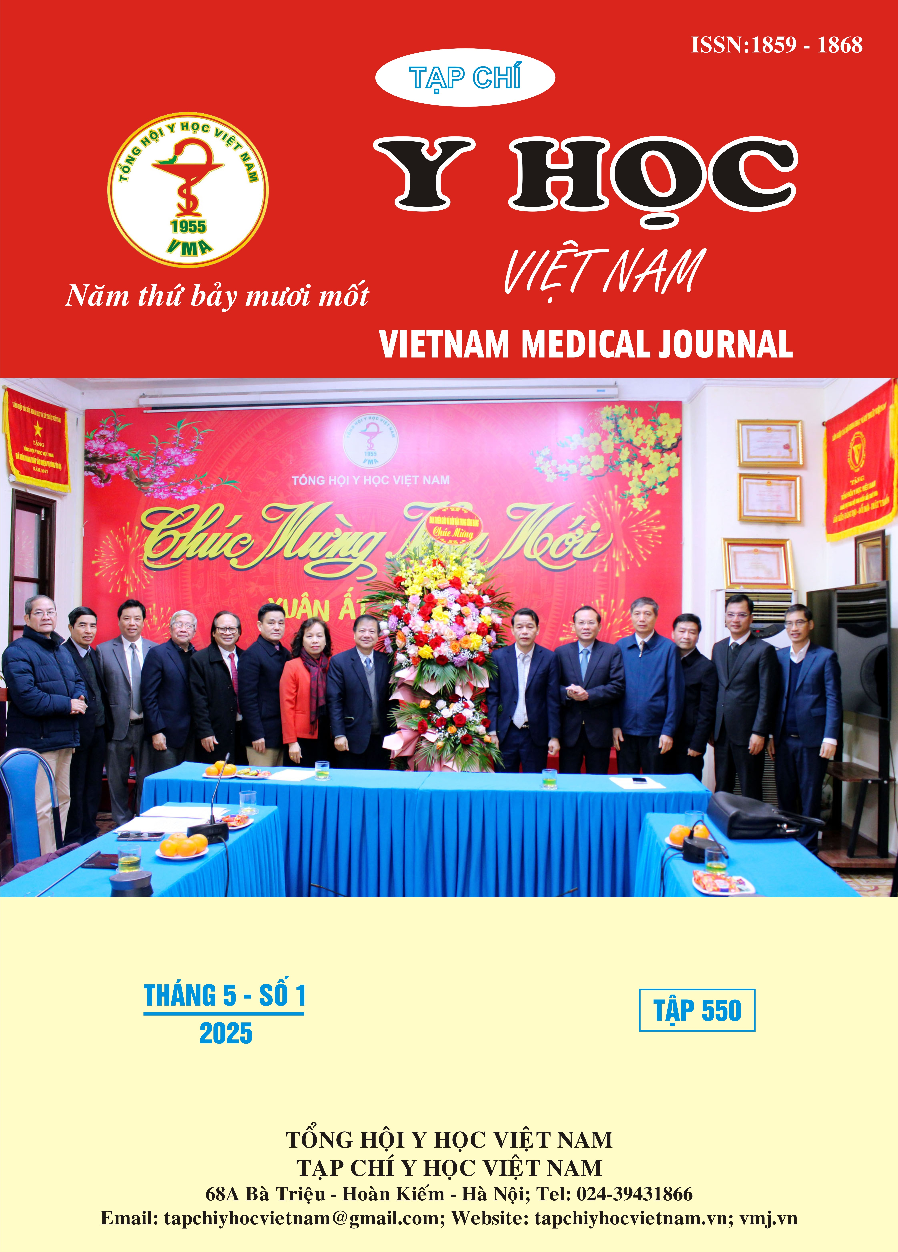CHARACTERISTICS OF CRANIOFACIAL BONES ACCORDING TO RICKETTS ANALYSIS IN 10-12-YEAR-OLD CLASS II CHILDREN WITH MANDIBULAR RETROGNATHIA IN HANOI CITY
Main Article Content
Abstract
Objective: To describe several craniofacial structural indices in 10-12-year-old Class II children with mandibular retrognathia using Ricketts analysis in Hanoi City. Subject and methods: A cross-sectional descriptive study was conducted on 78 Class II subjects with mandibular retrognathia (43 males and 35 females) using Ricketts lateral cephalometric analysis on the VNCEPH tracing software. Results: The anterior cranial base length (Cc-N) was 53,36±2,29mm; and the posterior cranial base length (Po-PtV) was 37,29±2,14mm. The cranial base inclination (BaN/FH) was 24,17±2,79°; the total facial height (BaN/XiPm) was 58,05±2,76mm and the lower facial height (ANS-Xi-Pm) was 46,92±2,43mm. The mandibular plane angle (GoMe/FH) was 32,26±2,57°; the mandibular body length (Xi-Pm) was 54,10±3,29mm and the mandibular arch angle (DcXi/XiPm) was 37,00±2,84°. The maxillary depth (N-A/FH) was 90,01±2,49° and the position of point A (Ba-N-A) was 62,59±2,31°. There were no significant differences between genders for these indices. However, facial convexity (A→NPog) (5,85±1,13mm), facial axis angle (CcGn/BaN) (82,69±2,43°) and facial depth (NPog/FH) (77,23±2,32°) were significantly higher in females than in males. Conclusions: The mandible tends to grow in a backward and downward rotation, exacerbating mandibular retrusion and limiting its forward growth.
Article Details
Keywords
later cephalometric, Ricketts analysis, skeletal class II
References
2. Tae Soo Park (1984). A longitudinal cephalometric study of craniofacial growth of Korean children, Korean Journal of Orthodontics, 14(2), 217-231.
3. Hideyuki Kato, Satoshi Fujii (1988). Application of the Ricketts Analysis to Children in the Primary Dentition: Second Report: A Study of Annual Growth, The Japanese Journal of Pediatric Dentistry, 26, 755-768.
4. Đống Khắc Thẩm, Hoàng Tử Hùng (2009). Tương quan giữa chiều dài nền sọ trước với xương hàm trên, xương hàm dưới và chiều cao tầng mặt, nghiên cứu dọc trên phim đo sọ ở trẻ từ 3-13 tuổi. Y học Thành phố Hồ Chí Minh, 13(1), 10-15.
5. Lê Võ Yến Nhi, Hoàng Tử Hùng (2011). Sự tăng trưởng sọ mặt ở trẻ em Việt Nam từ 10 -14 tuổi theo phân tích Ricketts. Y học Thành phố Hồ Chí Minh, 15(2), 21-30.
6. Lê Nguyên Lâm, Nguyễn Bắc Hùng (2014). Sự tăng trưởng của xương hàm dưới ở trẻ từ 12 – 15 tuổi theo phân tích Ricketts, Tạp chí Y học thực hành, 6(923), 67–71.
7. Phạm Cao Phong, Lê Gia Vinh, Võ Trương Như Ngọc (2016). Một số đặc điểm kết cấu sọ mặt ở nhóm học sinh người Việt lứa tuổi 11 trên phim sọ nghiêng, Tạp chí Y Học Việt Nam, 439(1), 36-40.
8. Phạm Cao Phong, Lê Gia Vinh (2016). Sự phát triển và sự xoay của xương hàm dưới lứa tuổi 11-12 trên phim sọ nghiêng, Tạp chí Y Học Việt Nam, 453(1), 7-9.
9. Nguyễn Thị Nga, Nguyễn Thị Thu Phương và cộng sự (2017). Đặc điểm sọ mặt ở một nhóm trẻ người Kinh 7 tuổi trên phim sọ nghiêng theo phân tích Ricketts, Tạp chí Y dược học quân sự, 42, 369-375.
10. Eun-ju Bae (2013). Changes in longitudinal craniofacial growth in subjects with normal occlusions using the Ricketts analysis, The Korean Journal of Orthodontics, 71-79.


